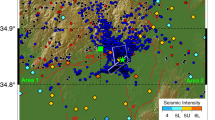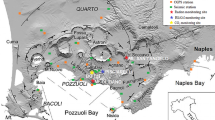Abstract
Earthquakes usually occur after some preliminary anomalies in the physical and chemical characteristics of environment and earth interior. Construction of the models which can explain these anomalies, prompt scientists to monitor geophysical and geochemical characteristics in the seismic areas for earthquake prediction. A review of studies has been done so far, denoted that radon gas shows more sensitivity than other geo-gas as a precursor. Based on previous researches, radon is a short-term precursor of earthquake from time point of view. There are equal experimental equations about the relation between earthquake magnitude and its effective distance on radon concentration variations. In this work, an algorithm based on Dobrovolsky equation \( (D = 10^{0.43M} ) \) with defining the Expectation and Investigation circles for great Tehran has been used. Radon concentration was measured with RAD7 detector in the more than 40 springs. Concentration of radon in spring, spring discharge, water temperature and the closeness of spring location to active faults, have been considered as the significant factors to select the best spring for a radon continuous monitoring site implementation. According to these factors, thirteen springs have been selected as follow: Bayjan, Mahallat-Hotel, Avaj, Aala, Larijan, Delir, Lavij, Ramsar, Semnan, Lavieh, Legahi, Kooteh-Koomeh and Sarein.









Similar content being viewed by others
Notes
International Association of Seismology and Physics of the Earth's Interior (www.iaspei.org).
Tehran, Mazandaran, Ardebil, Markazi, Zanjan, Semnan & Gilan.
The study region is full of different type faults (Dip slip, strike slip and oblique slip faults/Normal and Reverse faults/High angle and low angle faults/and any other classification of faults). But the above descriptions of faults are only based on seismicity rate of each one during the time and other factors of faults were not studied.
International Institute of Earthquake Engineering & Seismology (www.iiees.ac.ir).
References
Lay T, Wallace TC (1995) Modern global seismology, vol 58. Elsevier, Amsterdam
Chopra AK (1995) Dynamics of structures: theory and applications to earthquake engineering, vol 2. Prentice Hall, Englewood Cliffs, NJ
Shearer PM (2009) Introduction to seismology. Cambridge University Press, Cambridge
Kramer SL (1996) Geotechnical earthquake engineering. Pearson Education, Delhi, India
Turcotte DL, Schubert G (2002) Geodynamics. Cambridge University Press, Cambridge
Igarashi G, Saeki S, Takahata N, Sumikawa K, Tasaka S, Sasaki Y, Takahashi M, Sano Y (1995) Ground-water radon anomaly before the Kobe earthquake in Japan. Science 269:60–61
Wakita H, Nakamura Y, Notsu K, Noguchi M, Asada T (1980) Radon anomaly: a possible precursor of the 1978 Izu-Oshima-kinkai earthquake. Science 207(4433):882–883
Scholz CH, Sykes LR, Aggarwal YP (1973) Earthquake prediction: a physical basis. Science 181(4102):803–810
Fan K, Kuo T, Han Y, Chen C, Lin C, Lee C (2007) Radon distribution in a gasoline-contaminated aquifer. Radiat Meas 42(3):479–485. doi:10.1016/j.radmeas.2006.12.012
Nikolopoulos D, Vogiannis E, Petraki E, Zisos A, Louizi A (2010) Investigation of the exposure to radon and progeny in the thermal spas of Loutraki (Attica-Greece): results from measurements and modelling. Sci Total Environ 408(3):495–504. doi:10.1016/j.scitotenv.2009.09.057
King CY (1986) Gas geochemistry applied to earthquake prediction: an overview. J Geophys Res 91(B12):12269–12281
Noguchi M, Wakita H (1977) A method for continuous measurement of radon in groundwater for earthquake prediction. J Geophys Res 82(8):1353–1357
Namvaran M, Negarestani A (2013) Measuring the radon concentration and investigating the mechanism of decline prior an earthquake (Jooshan, SE of Iran). J Radioanalyt Nucl Chem 298:1–8
Namvaran M, Negarestani A (2013) Measurement of soluble radon in Jooshan spa (se of Iran) and study its performance in earthquake forecasting process. Romanian J Phys 58(3–4):373–382
Kagan YY, Jackson DD (1991) Long-term earthquake clustering. Geophys J Int 104(1):117–133
Hashemi SM, Negarestani A, Namvaran M, Musavi Nasab S (2013) An analytical algorithm for designing radon monitoring network to predict the location and magnitude of earthquakes. J Radioanalyt Nuclear Chem 295(3):2249–2262. doi:10.1007/s10967-012-2310-0
Gansser A (1955) New aspects of the geology in Central Iran. In: Fourth world petroleum congress, section I/A/5. Reprint 2, pp 280–300
McKenzie D (1978) Active tectonics of the Alpine—Himalayan belt: the Aegean Sea and surrounding regions. Geophys J Roy Astron Soc 55(1):217–254. doi:10.1111/j.1365-246X.1978.tb04759.x
Robert Engdahl E, Jackson JA, Myers SC, Bergman EA, Priestley K (2006) Relocation and assessment of seismicity in the Iran region. Geophys J Int 167(2):761–778
Berberian M, Yeats RS (1999) Patterns of historical earthquake rupture in the Iranian Plateau. Bull Seismol Soc Am 89(1):120–139
De Martini P, Hessami K, Pantosti D, D’Addezio G, Alinaghi H, Ghafory-Ashtiani M (1998) A geologic contribution to the evaluation of the seismic potential of the Kahrizak fault (Tehran, Iran). Tectonophysics 287(1):187–199
Bozorgnia F (1973) Paleozoic foraminiferal biostratigraphy of central and east Alborz Mountains, Iran, vol 4. National Iranian Oil Company, Tehran
Ashtari M, Hatzfeld D, Kamalian N (2005) Microseismicity in the region of Tehran. Tectonophysics 395(3):193–208
Ritz J-F, Nazari H, Ghassemi A, Salamati R, Shafei A, Solaymani S, Vernant P (2006) Active transtension inside central Alborz: a new insight into northern Iran–southern Caspian geodynamics. Geology 34(6):477–480
Allen M, Ghassemi M, Shahrabi M, Qorashi M (2003) Accommodation of late Cenozoic oblique shortening in the Alborz range, northern Iran. J Struct Geol 25(5):659–672
Ritz J, Balescu S, Soleymani S, Abbassi M, Nazari H, Feghhi K, Shabanian E, Tabassi H, Farbod Y, Lamothe M (2003) Determining the long-term slip rate along the Mosha Fault, Central Alborz, Iran. Implications in terms of seismic activity. In: Proceeding of the 4th international conference on seismology and earthquake engineering
Engdahl ER, van der Hilst R, Buland R (1998) Global teleseismic earthquake relocation with improved travel times and procedures for depth determination. Bull Seismol Soc Am 88(3):722–743
Ambraseys NN, Melville CP (2005) A history of Persian earthquakes. Cambridge University Press, Cambridge
Negarestani A, Setayeshi S, Ghannadi-Maragheh M, Akashe B (2002) Layered neural networks based analysis of radon concentration and environmental parameters in earthquake prediction. J Environ Radioact 62(3):225–233
Porstendörfer J, Butterweck G, Reineking A (1991) Diurnal variation of the concentrations of radon and its short-lived daughters in the atmosphere near the ground. Atmospheric Environ A 25(3):709–713
Shapiro M, Rice A, Mendenhall M, Melvin J, Tombrello T (1984) Recognition of environmentally caused variations in radon time series. Pure Appl Geophys 122(2–4):309–326
Schubert M, Schulz H (2002) Diurnal radon variations in the upper soil layers and at the soil-air interface related to meteorological parameters. Health Phys 83(1):91–96
Mattsson R (1970) Seasonal variation of short-lived radon progeny, Pb210 and Po210, in ground level air in Finland. J Geophys Res 75(9):1741–1744
Sherwood R (1976) Ostwald solubility coefficients of some industrially important substances. Br J Ind Med 33(2):106–107
Steward A, Allott P, Cowles A, Mapleson W (1973) Solubility coefficients for inhaled anaesthetics for water, oil and biological media. Br J Anaesth 45(3):282–293
Nussbaum E, Harsh JB (1958) Radon solubility in fatty acids and triglycerides. J Phys Chem 62(1):81–84
Dobrovolsky I, Zubkov S, Miachkin V (1979) Estimation of the size of earthquake preparation zones. Pure Appl Geophys 117(5):1025–1044
Musavi Nasab SM, Negarestani A, Mohammadi S (2011) Modeling of the radon exhalation from water to air by a hybrid electrical circuit. J Radioanal Nucl Chem 288(3):813–818. doi:10.1007/s10967-011-1003-4
Author information
Authors and Affiliations
Corresponding author
Rights and permissions
About this article
Cite this article
Negarestani, A., Namvaran, M., Shahpasandzadeh, M. et al. Design and investigation of a continuous radon monitoring network for earthquake precursory process in Great Tehran. J Radioanal Nucl Chem 300, 757–767 (2014). https://doi.org/10.1007/s10967-014-3020-6
Received:
Published:
Issue Date:
DOI: https://doi.org/10.1007/s10967-014-3020-6




